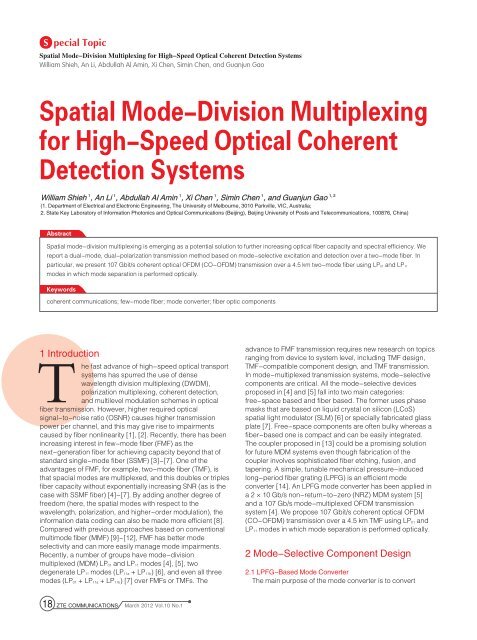ZTE Communications
ZTE Communications
ZTE Communications
Create successful ePaper yourself
Turn your PDF publications into a flip-book with our unique Google optimized e-Paper software.
S pecial Topic<br />
Spatial Mode-Division Multiplexing for High-Speed Optical Coherent Detection Systems<br />
William Shieh, An Li, Abdullah Al Amin, Xi Chen, Simin Chen, and Guanjun Gao<br />
Spatial Mode-Division Multiplexing<br />
for High-Speed Optical Coherent<br />
Detection Systems<br />
William William Shieh Shieh 1 1 1 1 1 1, 2<br />
, , An An Li Li , , Abdullah Abdullah Al Al Amin Amin , , Xi Xi Chen Chen , , Simin Simin Chen Chen , , and and Guanjun Guanjun Gao Gao<br />
(1. Department of Electrical and Electronic Engineering, The University of Melbourne, 3010 Parkville, VIC, Australia;<br />
2. State Key Laboratory of Information Photonics and Optical <strong>Communications</strong> (Beijing), Beijing University of Posts and Telecommunications, 100876, China)<br />
Abstract<br />
Spatial mode-division multiplexing is emerging as a potential solution to further increasing optical fiber capacity and spectral efficiency. We<br />
report a dual-mode, dual-polarization transmission method based on mode-selective excitation and detection over a two-mode fiber. In<br />
particular, we present 107 Gbit/s coherent optical OFDM (CO-OFDM) transmission over a 4.5 km two-mode fiber using LP01 and LP11<br />
modes in which mode separation is performed optically.<br />
Keywords<br />
coherent communications; few-mode fiber; mode converter; fiber optic components<br />
T1 Introduction<br />
he fast advance of high-speed optical transport<br />
systems has spurred the use of dense<br />
wavelength division multiplexing (DWDM),<br />
polarization multiplexing, coherent detection,<br />
and multilevel modulation schemes in optical<br />
fiber transmission. However, higher required optical<br />
signal-to-noise ratio (OSNR) causes higher transmission<br />
power per channel, and this may give rise to impairments<br />
caused by fiber nonlinearity [1], [2]. Recently, there has been<br />
increasing interest in few-mode fiber (FMF) as the<br />
next-generation fiber for achieving capacity beyond that of<br />
standard single-mode fiber (SSMF) [3]-[7]. One of the<br />
advantages of FMF, for example, two-mode fiber (TMF), is<br />
that spacial modes are multiplexed, and this doubles or triples<br />
fiber capacity without exponentially increasing SNR (as is the<br />
case with SSMF fiber) [4]-[7]. By adding another degree of<br />
freedom (here, the spatial modes with respect to the<br />
wavelength, polarization, and higher-order modulation), the<br />
information data coding can also be made more efficient [8].<br />
Compared with previous approaches based on conventional<br />
multimode fiber (MMF) [9]-[12], FMF has better mode<br />
selectivity and can more easily manage mode impairments.<br />
Recently, a number of groups have mode-division<br />
multiplexed (MDM) LP01 and LP11 modes [4], [5], two<br />
degenerate LP11 modes (LP11a + LP11b) [6], and even all three<br />
modes (LP01 + LP11a + LP11b) [7] over FMFs or TMFs. The<br />
18<br />
<strong>ZTE</strong> COMMUNICATIONS<br />
March 2012 Vol.10 No.1<br />
advance to FMF transmission requires new research on topics<br />
ranging from device to system level, including TMF design,<br />
TMF-compatible component design, and TMF transmission.<br />
In mode-multiplexed transmission systems, mode-selective<br />
components are critical. All the mode-selective devices<br />
proposed in [4] and [5] fall into two main categories:<br />
free-space based and fiber based. The former uses phase<br />
masks that are based on liquid crystal on silicon (LCoS)<br />
spatial light modulator (SLM) [6] or specially fabricated glass<br />
plate [7]. Free-space components are often bulky whereas a<br />
fiber-based one is compact and can be easily integrated.<br />
The coupler proposed in [13] could be a promising solution<br />
for future MDM systems even though fabrication of the<br />
coupler involves sophisticated fiber etching, fusion, and<br />
tapering. A simple, tunable mechanical pressure-induced<br />
long-period fiber grating (LPFG) is an efficient mode<br />
converter [14]. An LPFG mode converter has been applied in<br />
a 2 × 10 Gb/s non-return-to-zero (NRZ) MDM system [5]<br />
and a 107 Gb/s mode-multiplexed OFDM transmission<br />
system [4]. We propose 107 Gbit/s coherent optical OFDM<br />
(CO-OFDM) transmission over a 4.5 km TMF using LP01 and<br />
LP11 modes in which mode separation is performed optically.<br />
2 Mode-Selective Component Design<br />
2.1 LPFG-Based Mode Converter<br />
The main purpose of the mode converter is to convert

















